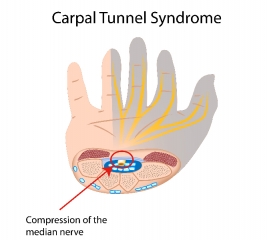What is Carpal Tunnel Syndrome (CTS)?
Carpal Tunnel Syndrome is the pain of the hand at the palmer area with the involvement of thumb, index finger, middle finger and half of ring finger. It is due to the median nerve repetitive compression injury at the carpal tunnel of the wrist.
Median nerve gives you the sensation of the hand and control the movement of thumb and wrist. This is the most common nerve entrapment disease. About 3 to 6% of general adult population suffers from carpal tunnel syndrome.
Who gets it?
· Laborers and freight, stock, and material, movers
· Customer service representatives
· First-line supervisors/managers of office and administrative support workers
· Janitors, maids, and housekeeping cleaners
· Food service managers
· First-line supervisors/managers of retail sales workers
· Automotive service technicians and mechanics
· Executive secretaries and administrative assistants
· Financial managers
· Sewing machine operators
· Truck drivers
· Office clerks
· Accounting and auditing clerks
· Welders, cutters, solderers, and brazers
· Sheet metal workers
· Packers and packagers
· Computer software engineers
· Inspectors, testers, sorters, samplers, and weighers
· Stock clerks and order fillers
· Packaging and filling machine operators and tenders
Also people with smoking habit, increased alcohol intake or diabetic tend to have high chance of developing CTS as well. Women with pregnancy tend to temporarily develop CTS due to water retention around the wrist. This water build up will compress the median nerve at the carpal tunnel.
How do I know if I have CTS?
If you feel tingling and pain of the hand, wake up at night, drop the glass or object from your hand, small muscle bulk on the side of the thumb as compare to the non symptomatic hand and constant shaking your hand trying to get some relief, then you will have high chance of having CTS.
The accurate diagnose is established by electrodiagnostic testing. It is usually known as NCV/EMG testing. This can be done by physicians or physical therapists with electrodiagnostic testing training.
What are the treatment options?
Besides resting and avoiding repetitive wrist bending activity, mild type of CTS usually responds well with conservative treatment such as wrist splint, ultrasound, massage, stretching exercise and median nerve glide therapy. Once a woman with pregnancy-associated CTS gives birth, for instance, the swelling in her wrists and other symptoms almost always subside. Some people also respond well with acupuncture and corticosteroid injection. If no significant change after 6 to 8 weeks conservative treatment, carpal tunnel release surgery will probably be the next option.
Prevention of Carpal Tunnel Syndrome
There are some preventive measures to mitigate the CTS development.
- Maintain a healthy weight
- Avoid smoking and alcohol intake
- Get regular exercises
- Keep your arm, hand, and finger muscles strong and flexible
- Wear a wrist splint to keep your wrist in a neutral position
- Switch hands and change positions
- Avoid repetitive wrist activity
- Maintain correct posture
- Arrange your workstation with sound ergonomic
- Restrict salt intake if you tend to retain fluid

